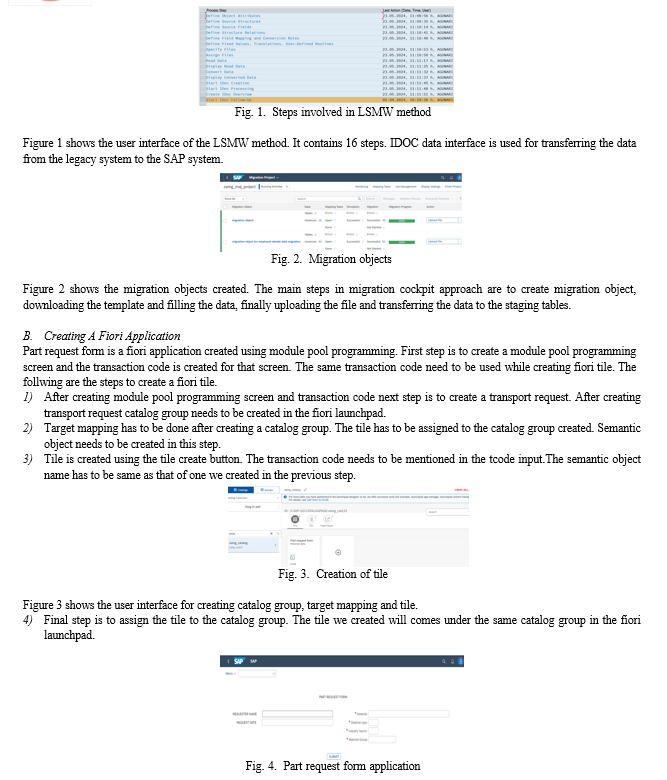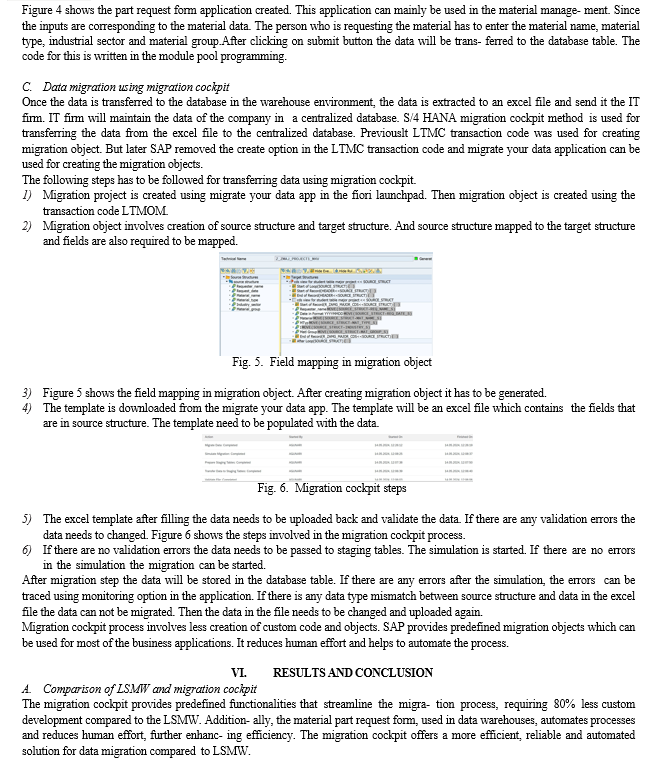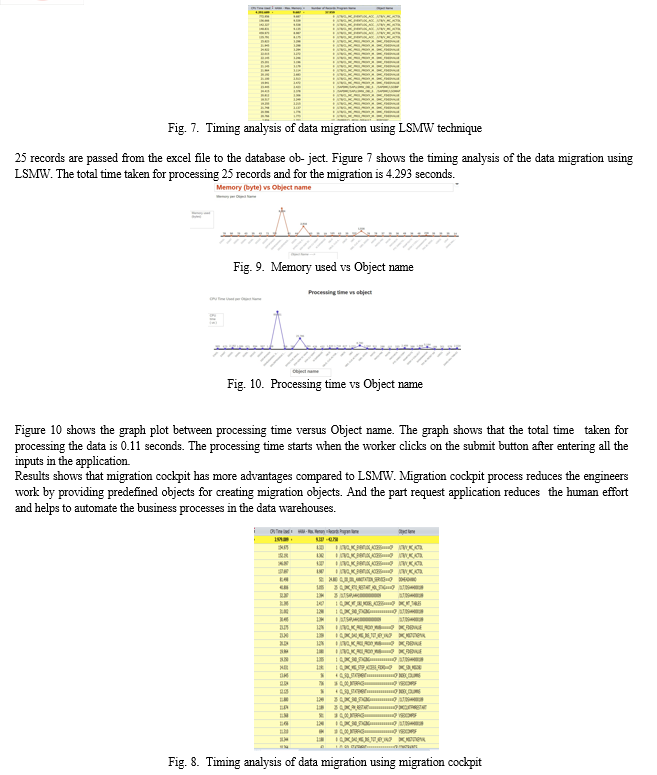Ijraset Journal For Research in Applied Science and Engineering Technology
- Home / Ijraset
- On This Page
- Abstract
- Introduction
- References
- Copyright
Design of Part Request Form Application and Data Migration
Authors: Abhishek Maningappa Gunari, Rajani Katiyar, Sahana B
DOI Link: https://doi.org/10.22214/ijraset.2024.63129
Certificate: View Certificate
Abstract
The migration of the data form legacy systems to modern enterprise solutions is critical for optimizing business processes and enhancing performance. This paper focuses on comparison of the data migration techniques LSMW and S/4 HANA migration cockpit. The main objective is to optimize the business process through the creation of Part Request Form ap- plication in fiori launchpad and performing data migration using S/4 High performance analytic appliance(HANA) migration cock- pit. Traditional methods of data migration has several problems, including performance bottlenecks. Addressing this limitation is essential to ensure seamless data transfer and accurate system integration. This report explores these issues and presents a methodology to address them by using advanced capabilities of the S/4 HANA Migration Cockpit over the conventional Legacy system migration workbench(LSMW) tool. The primary objective of this work is to optimize business process using part request form application. The data comes from the application will be saved in the database table in the user system. That data is extracted into a file and send it to the IT firm where that data will be migrated to the HANA database. The tool used for the data migration is s/4 HANA migration cockpit. The software used for this project is SAP-ERP software. The Results from the simulation shows that migration cockpit process is 48% faster than LSMW technique. The part request form application uses 12 kilo bytes of memory which is very less and the processing time is 0.1 seconds which is very less. These results highlight advantages of using an application in data warehouse and the effectiveness of the S/4 HANA Migration Cockpit in optimizing business processes within warehouse environment.
Introduction
I. INTRODUCTION
The technology in Enterprise resource planning(ERP) is ad- vancing day by day. It made essential for the business to move from the SAP ERP central component(ECC) to the s/4 High performance analytic appliance(HANA) environment. The part request application can be used in the business warehouse environments to get the data from the workers. Later they send that data to the IT firm where the engineers transfer the data to the centralized database using data migration. There are many data migration techniques available in SAP such as (LSMW), S/4 HANA migration cockpit, (BDC). The newer and efficient approach is to use S/4 HANA migration cockpit. The main fo- cus here is to improve warehouse operations through efficient data migration techniques and SAP-fiori applications. SAP fiori application is created using module pool programming.
First step is to create a screen in module pool and then next step is to create a tile in fiori launchpad. Data migration is performed using migrate your data application.
II. PROBLEM STATEMENT
The requests from the user in the warehouse management has to be processed in a faster rate. So there is a requirement to design an application and migrate the data stored from the application to the HANA database.
III. LITERATURE SURVEY
SAP is the most widely used ERP software in the organiza- tions. Enterprise Resource Planning systems are software plat- forms designed to manage and integrate the business processes of an organization across various departments. [1] ABAP is the programming language used in SAP software. RICE stands for reports, interfaces, conversions, enhancements. These are the development works that we can carry in SAP.[2] Explains the use of Intermediate Document technology based on XML techniques as a method for ensuring efficient data exchange between enterprise resource planning systems and other por- tal applications.[3] Intermediate Document technology is a method for ensuring efficient data exchange between enterprise resource planning systems and other portal applications.[4] Creating source and target structure is the important step while creating migration object.
Developing detailed data mapping and transformation rules to ensure alignment between source and target data structures.[5] S/4 HANA is noted for its advanced capabilities in analytics, real time data processing and overall improved performance, which are essential for creating an intelligent enterprise.The paper identifies several challenges, such as data migration difficulties, issues inte- grating with existing systems, the necessity for extensive user training, and the potential for operational disruptions. To mitigate these risks, the paper recommends thorough planning and conducting extensive testing.[6] SAP fiori is recognized for its user centric design. The paper [7] suggests that SAP fiori acts as a catalyst for innovation by streamlining complex processes and making it easier for users to perform their tasks efficiently. Additionally, it examines how the adoption of SAP fiori influences socio technical dynamics by changing how users interact with technology in their work environments. The study in [8] highlights the benefits of using SAP fiori for its intuitive interface and how it simplifies user interactions with metrology applications. The integration of these technologies enhances data accessibility and accuracy, streamlines calibra- tion processes, and improves overall operational efficiency.The paper [9] underscores the importance of this transition in maintaining competitive advantage and achieving supply chain excellence in the digital era. This paper [10] explores how SAP technology revolutionizes business processes from a buyer’s perspective. It discusses the various SAP solutions that enhance business operations, such as SAP S/4 HANA for real- time analytics, SAP fiori for improved user experience, and cloud-based solutions for scalability and flexibility.
The overall study tells that S/4 HANA migration cockpit is an efficient method in terms of time and memory consumed. It is a new approach and compatible for both SAP ECC and S/4 HANA. SAP applications can be used in the warehouse environments for optimizing business processes in terms of time.
IV. METHODOLOGY
A. Creating Part Request Form Application
Warehouse management involves maintaining activities that go in a business’s warehouse, including order fulfillment and shipping. The main warehouse management processes are receiving, Picking, Packing, Shipping, Reporting. Whenever the worker in the warehouse require a particular material he has to request to the supervisor. Instead of this, part request from application can be used. Worker just enter the material data in the form and submit it. After submitting the form the data will be stored in their own databases. That data need to be passed to the IT service consultants process the data and transfer the data to HANA database. All the workers of the warehouse can access the data and process the request. Storing this data helps to calculate the expense and it can also be used for future prediction. This application can be created using module pool programming. First the screen has to created in the module pool and later fiori tile has to be created in the fiori launchpad using the transaction code created for the module pool screen.
B. Data migration using migration cockpit
The data entered by the worker in the warehouse is stored in their own database. Later that data need to be transferred to the IT firm, where the engineers migrate that data to the centralized database of the company. The main techniques used for the data migration are LSMW and migration cockpit. LSMW is the older technique and it takes more time for the data migration. LSMW only supported by SAP ECC. S/4 HANA does not support LSMW approach. So it is better to use migration cockpit approach for data migration. Before performing the data migration the data needs to be validated. Once the data is validated then the data can be migrated. LTMOM is the transaction code used for creating migration object in the SAP software. The migration object contains source structure and target structure. Structure mapping and field mapping needs to be done while creating migration object.
V. IMPLEMENTATION
A. Comparison of LSMW and migration cockpit
In migration cockpit more than 200 migration objects can be created for ERP sources and excel template files delivered. In LSMW no need to create migration objects. We use IDOC for the delivery. For Direct Transfer in migration cockpit installation of DMIS add-on in the source system is necessary. In SAP standard delivery IDOC/ALE have to be configured. Migration cockpits are supported by SAP fiori and SAP gui. LSMW is supported only in SAP GUI. In migration cockpit data is created using SAP standard API’s, Restfull Application programming and business objects. In LSMW we use BAPI, IDOC.
SAP S/4 HANA provides predefined objects. It Reduce ef- fort and save time. Structure mapping to SAP S/4 HANA data model is simple. 80% less custom developments compared to other techniques. It is simple to create migration object in the transaction LTMOM. Migration cockpit provides simulation procedure using we can reduce errors by 50%.



Figure 8 shows the timing analysis of the data migration using migration cockpit approach. The processing time taken in this process is 2.979 seconds, which is less compared to LSMW technique. With this result, migration cockpit is 48% faster and 1.48 times effective than LSMW technique. Figure
5.1 and 5.2 shows that the memory consumed by the migration cockpit process is 9.32 MB is less than the memory consumed by LSMW approach which is 9.68 MB.
B. Performance analysis of Part request form
The part request form application is created using in fiori launchpad. The performance of the part request form is ana- lyzed using the ST05 transaction code and the data is obtained. The graphs plotted using SAP analytics cloud. SAP analytics cloud is a tools for visualizing the data.
Figure 9 is the plot of memory used versus object name. When the worker in the warehouse enter the data in the appli- cation and clicks on the submit button the processing will start. The total memory consumed is around 13 kilo bytes. When the application starts executing SAP automatically creates objects for the internal operations.
References
[1] M. Orlowska, “Sap erp software as a tool for managing the logistics subsystems of an enterprise,” Jul. 2023. [2] A. Zafar, D. Alturi, S. Taur, and M. R. Gor, ”RISE with SAP towards a Sustainable Enterprise: Become a value-driven, sustainable, and resilient enterprise using RISE with SAP” 2023. [3] K Chaitanya and B. C. Mallikarjun, “A service migration strategy for communica- tion networks,” in 2022 IEEE 3rd Global Conference for Advancement in Technology (GCAT), 2022, pp. 1–4. [4] N. Jain and T. Bagga, “Sap s/4 hana framework: I-erp towards digital transfor- mation,” in 2021 9th International Conference on Reliability, Infocom Technologies and Optimization (Trends and Future Directions) (ICRITO), 2021, pp. 1–6. doi: 10.1109/ICRITO51393.2021.9596165. [5] A. Selmeci and T. Orosz, “Sap remote communications,” in 2012 7th IEEE International Symposium on Applied Computa- tional Intelligence and Informatics (SACI), 2012, pp. 303–309. doi: 10.1109/SACI.2012.6250020. [6] V. Chang, P. Arunachalam, Q. A. Xu, P. L. Chong, C. Psarros, and J. Li, “Journey to sap s/4hana intelligent enterprise: Is there a risk in transitions?” International Journal of Business Information Systems, vol. 42, no. 3-4, pp. 503–541, 2023. doi: 10.1504/IJBIS.2023.129698. eprint: https://www.inderscienceonline.com/ doi / pdf / 10 . 1504 / IJBIS . 2023 . 129698. [Online]. Available: https : / / www . inderscienceon- line.com/doi/abs/10.1504/IJBIS.2023.129698. [7] M. Suder and T. Gospodarek, “SAP fiori as a cause of innovation and sociotechnical system arising,” in Communication Papers of the 17th Conference on Computer Science and Intelligence Systems, PTI, Sep. 2022 [8] B. V. Costin and D. Cojocaru, “Integration of metrology applications in the calibration reservoir suites using sap fiori, portal and cloud. a study case,” in 2017 21st International Conference on System Theory, Control and Computing (ICSTCC), 2017, pp. 297–302. doi: 10.1109/IC- STCC.2017.8107050. [9] D. Kumar Vaka Rajesh, “Transitioning to S/4HANA: Futureproofing of cross industry business for supply chain digital excellence,” Int. J. Sci. Res. (Raipur), vol. 13, no. 4, pp. 488–494, Apr. 2024 [10] R. Dave, B. Sarkar, and G. Singh, “Revolutionizing business processes with SAP technology: A buyer’s perspective,” Int. J. Comput. Trends Technol., vol. 71, no. 4, Apr. 2023 [11] M. Orlowska, “Sap erp software as a tool for managing the logistics subsystems of an enterprise,” Jul. 2023. doi: 10.29119/1641-3466.2023. [12] A. Zafar, D. Alturi, S. Taur, and M. R. Gor, RISE with SAP towards a Sustainable Enterprise: Become a value-driven, sustainable, and resilient enterprise using RISE with SAP. 2023. [13] A. Zafar, D. Alturi, S. Taur, and M. R. Gor, RISE with SAP towards a Sustainable Enterprise: Become a value-driven, sustainable, and resilient enterprise using RISE with SAP. 2023. [14] Y. T. Prasetyo and K. O. S. Soliman, “Usability evaluation of erp systems: A comparison between sap s/4 hana and oracle cloud,” in 2021 IEEE 8th International Conference on Industrial Engineering and Applications (ICIEA), 2021, pp. 120 125. doi: 10.1109/ICIEA52957.2021.9436697. [15] N. Jain and T. Bagga, “Sap s/4 hana framework: I-erp towards digital transformation,” in 2021 9th International Conference on Reliability, Infocom Technologies and Optimization (Trends and Future Directions) (ICRITO), 2021, pp. 1–6. doi: 10.1109/ICRITO51393.2021.9596165. [16] N. Jain, T. Bagga, and A. Tripathi, “I-erp intelligent system modelling and interfacing : Excel with sap hana,” in 2022 International Conference on Computing, Communication, and Intelligent Systems (ICCCIS), 2022, pp. 479–483. doi: 10.1109/ICCCIS56430.2022.10037607. [17] A. N. Sisyukov, V. K. Bondarev, and O. S. Yulmetova, “Erp data analysis and visualization in high-performance computing environment,” in 2020 IEEE Conference of Russian Young Researchers in Electri- cal and Electronic Engineering (EIConRus), 2020, pp. 509–512. doi: 10.1109/EIConRus49466.2020.9038949. [18] A. MohamedLamey, H. Mousa, and A. Keshk, “Improve performance of enterprise information sap portal,” International Journal of Computer Applications, vol. 37, pp. 1–5, Jan. 2012. doi: 10.5120/4569-6514. [19] A. Selmeci and T. Orosz, “Sap remote communications,” in 2012 7th IEEE International Symposium on Applied Computa- tional Intelligence and Informatics (SACI), 2012, pp. 303–309. doi: 10.1109/SACI.2012.6250020. [20] L. Shabnam, F. Haque, M. Bhuiyan, and A. Krishna, “Software-as-a- service solution implementation – data migration perspective,” in 2014 IEEE 38th Annual Computer Software and Applications Conference, 2014, pp. 612–613. doi: 10.1109/ COMPSAC.2014.90 [21] D Asha and B. S. kariyappa, “Interface between clarity PPM and external system- SAP PS”,” IJAST, vol. 29, no. 7, pp. 8344–8352, 2020. UG Major Project Report Department of ECE, 2023-24 50
Copyright
Copyright © 2024 Abhishek Maningappa Gunari, Rajani Katiyar, Sahana B. This is an open access article distributed under the Creative Commons Attribution License, which permits unrestricted use, distribution, and reproduction in any medium, provided the original work is properly cited.

Download Paper
Paper Id : IJRASET63129
Publish Date : 2024-06-05
ISSN : 2321-9653
Publisher Name : IJRASET
DOI Link : Click Here
 Submit Paper Online
Submit Paper Online

